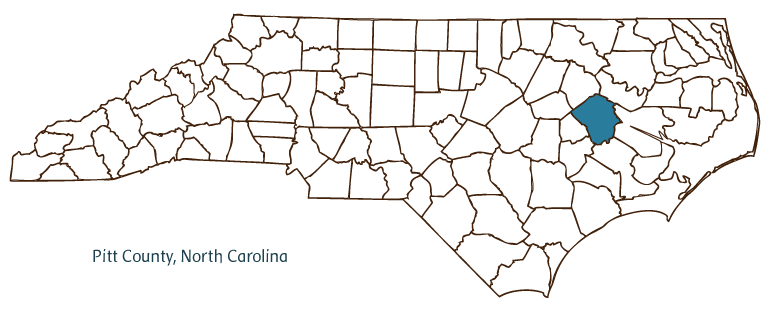PITT COUNTY GOVERNMENT:
www.pittcountync.gov
COUNTY SEAT: Greenville
FORMED: 1760
FORMED FROM: Beaufort
LAND AREA: 651.98 square miles
2020 POPULATION ESTIMATE: 170,243
White: 59.1%
Black/African American: 35.9%
American Indian: 0.5%
Asian: 2.1%
Pacific Islander: 0.1%
Two or more races: 2.2%
Hispanic/Latino: 6.5% (of any race)
From State & County QuickFacts, US Census Bureau, 2020.
CONGRESSIONAL DISTRICT: 1ST, 3RD
BIOGRAPHIES FOR![]()
Pitt County
 WILDLIFE PROFILES FOR
WILDLIFE PROFILES FOR
Coastal Plain
GEOGRAPHIC INFORMATION
REGION: Coastal Plain
RIVER BASIN: Neuse, Tar-Pamlico, Map
NEIGHBORING COUNTIES: Beaufort, Craven, Edgecombe, Greene, Lenoir, Martin, Wilson

Pitt County, located in the Coastal Plain region of eastern North Carolina, was formed in 1760 from Beaufort County and named for William Pitt, earl of Chatham. Early inhabitants of the area included the Tuscarora Indians, followed by English and Welsh settlers. The site of Catechna, a fortified Tuscarora town and the site of a siege by Col. John "Jack" Barnwell and his troops in April 1712, is north of Grifton. Greenville, the county seat, was incorporated in 1771 as Martinsborough, named for North Carolina's last royal governor, Josiah Martin; in 1786, the name was changed to Greenville in honor of Revolutionary general Nathanael Greene. Other Pitt County communities include Ayden, Bethel, Simpson, Black Jack, Calico, and Toddy. Notable among the physical features of the county are the Tar River, Clayroot Swamp, Pinelog Branch, Grindle Creek, Pea Branch, and Lake Kristi.
East Carolina University (founded in 1907 as the East Carolina Teachers Training School), located in Greenville, has a tremendous cultural and economic influence on the county. Pitt County historic structures include several buildings on the East Carolina campus as well as the Pitt County Courthouse (1910-11). Non-university-related cultural institutions include the Greenville Museum of Art, the Nature Science Center, Ayden's Art and Recreation Center, the Dance Arts Theatre, and the Adventures in Health Children's Museum. The county hosts annual events and festivals such as Winterville Watermelon Festival, the Farmville Dogwood Festival, and the Ayden Collard Festival.
Pitt County is a producer of tobacco, soybeans, grain, peanuts, vegetables, eggs, and swine and other livestock. County manufactures include textiles, pharmaceuticals, concrete products, and furnaces. Flooding of the Tar River as a result of Hurricane Floyd in 1999 caused more than $1.5 billion in damages to Pitt County communities and businesses. In 2004 the county's estimated population was 141,500.
Annotated history of Pitt County's formation:
For an annotated history of the county's formation, with the laws affecting the county, boundary lines and changes, and other origin information, visit these references in The Formation of the North Carolina Counties (Corbitt, 2000), available online at North Carolina Digital Collections (note, there may be additional items of interest for the county not listed here):
County formation history: https://digital.ncdcr.gov/Documents/Detail/the-formation-of-the-north-ca...
Index entry for the county: https://digital.ncdcr.gov/Documents/Detail/the-formation-of-the-north-ca...
Additional resources:
Corbitt, David Leroy. The Formation of the North Carolina Counties, 1663-1943. Raleigh: Division of Archives and History, North Carolina Department of Cultural Resources, 1987. https://digital.ncdcr.gov/Documents/Detail/the-formation-of-the-north-carolina-counties-1663-1943/3692099?item=4553233 (accessed June 20, 2017).
Pitt County Government. "Pitt County, North Carolina." https://www.pittcountync.gov/ (accessed February 15, 2019).
Greenville-Pitt County Chamber of Commerce. "Welcome to the Greenvill-Pitt County Chamber of Commerce." https://www.greenvillenc.org/ (accessed February 15, 2019).
DigitalNC. "Pitt County." North Carolina Digital Heritage Center. https://www.digitalnc.org/counties/pitt-county/ (accessed February 15, 2019).
North Carolina Digital Collections. "Explore by ... [place, time period, format]." North Carolina Department of Natural and Cultural Resources. https://digital.ncdcr.gov (accessed February 15, 2019).
Image credits:
Rudersdorf, Amy. "NC County Maps." Raleigh: Government & Heritage Library, State Library of North Carolina, 2010.
1 January 2006 | Mazzocchi, Jay
